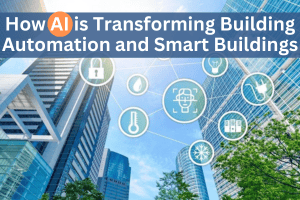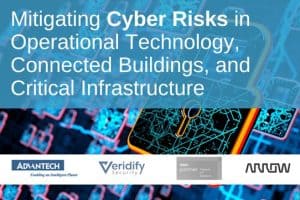Building Automation Systems, Smart Buildings, and 5 Ways to Make Them Cyber Secure
Watch this webinar replay of “Building Automation Systems, Smart Buildings, and 5 Ways to Make Them Cyber Secure” to learn about cybersecurity for buildings.
Key Topics
Buildings are becoming more connected and more at risk to cyberattacks. This webinar will address the following items:
• Connected building trends
• Building controls advancements and operating efficiencies
• Connected building and BACnet security risks
• 5 ways to improve building cybersecurity
• Cybersecurity for BACnet devices
Building Automation Systems, Smart Buildings, and 5 Ways to Make Them Cyber Secure
Speakers:
Tim Vogel – VP, Connected Solutions, KMC Controls
Louis Parks – CEO, Veridify Security
Webinar Summary
In this informative webinar, Tim Vogel from KMC Controls and Louis Parks from Verify Security discuss the growing importance of cyber security in smart buildings and automation systems. Aimed at stakeholders in building management, they outline how new technologies, including interoperability, augmented reality, and cloud-based systems, are shaping the future of building automation. Central to the discussion is the rising concern of cyber threats, particularly as buildings become increasingly interconnected. Vogel emphasizes the role of interoperability and open-source solutions in modern automation, while Parks details the mechanics of cyber security and proposed actionable measures for building owners to protect vulnerable systems and devices. Attendees are guided on methods to enhance building cyber security, including asset identification, password management, and device-level protection strategies.
Highlights
- Growing Interconnectivity: The rise of smart buildings comes with a complex web of interconnected systems, forming a larger attack surface for potential cyber threats.
- Interoperability Matters: The demand for interoperability has led to the adoption of centralized protocols, promoting seamless integration among different systems and vendors.
- Emergence of Digital Twins: Digital twins facilitate real-time visualization of building systems, enabling enhanced data analysis and operational efficiencies.
- Analytic-driven AI Implementations: The use of artificial intelligence and machine learning in building automation promotes energy efficiency and predictive maintenance through automated analytics.
- Zero Trust Security Framework: Implementing a zero trust security model validates every device and network communication, minimizing the risk of unauthorized access.
- Device-Level Security: Integrating device-level security solutions can proactively protect connected devices in buildings, addressing traditional vulnerabilities in legacy systems.
- Introducing Actionable Solutions: The presenters outline five immediate steps building owners can take to bolster their cyber security posture, reinforcing the need for proactive measures in the face of rising threats.
Key Insights
- Rising Security Risks: As smart buildings integrate more operational technology (OT) systems, they face heightened vulnerabilities. Attacks could involve unauthorized access to critical systems that control HVAC, lighting, and security, leading to operational disruptions or data breaches.
- Future of Open-Source Solutions: Open-source solutions are gaining traction in the building automation industry. Such technologies reduce vendor lock-in and foster collaboration among vendors, which ultimately benefits stakeholders through improved interoperability and customizability.
- Consumer Expectations Drive Innovation: Consumer technologies like smart home devices influence expectations in commercial spaces, pushing for more user-friendly interfaces and intuitive operation, leading to the demand for similar smart building functionalities.
- Data Accessibility Drives Efficiency: Enhanced data accessibility has led to increased efficiencies in energy management and operational performance. As organizations seek to lower energy costs and carbon footprints, analytics play a crucial role in driving these outcomes.
- Digital Twins as a Strategic Resource: Digital twins are revolutionizing the maintenance and operation of buildings by providing real-time data and a virtual representation of physical assets, enabling better decision-making regarding building management.
- Action Items for Building Owners: Parks emphasizes the importance of taking immediate steps to protect against cyber threats, which include identifying assets, ensuring robust password management, and limiting device access to enhance security.
- Importance of Robust Cyber Hygiene: Consistently implementing cyber hygiene practices can help mitigate risks associated with cyber threats. Organizations should prioritize regular assessments, vigilance, and a layered security approach to safeguard connected building systems.
Conclusion
The webinar focuses on the many changes and advancements within the realm of building automation systems, particularly emphasizing cyber security’s critical role in this rapidly evolving field. As organizations look to implement new technologies, they must also remain vigilant about the potential for cyber threats that accompany increased interconnectivity. The presenters provide a detailed overview of the current landscape, actionable insights, and practical measures to improve security. Building owners and facility managers must actively engage in protecting their assets through continued education, strategic planning, and embracing innovative solutions that ensure both safety and efficiency in their environments.
—
Blog Post Summary – All of our posts listed on one page back through 2019
See the slides below to learn more about cybersecurity for building controls and smart buildings:




